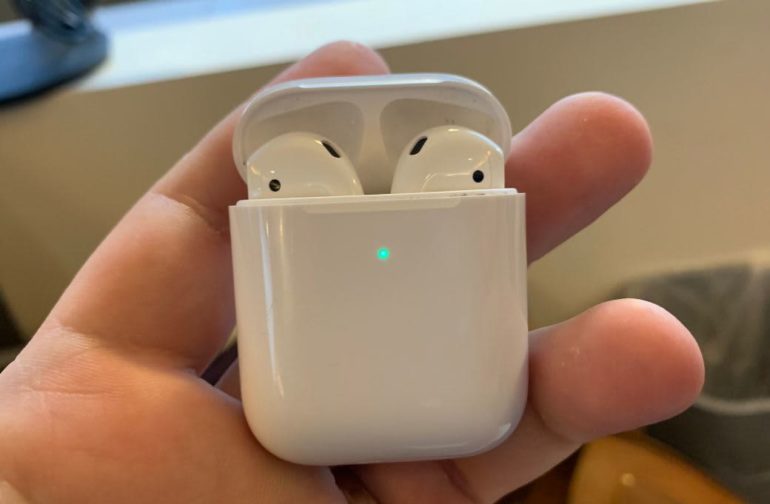When AirPods were first released in 2016, they were a marvel of miniaturization.
To ditch cords and go wireless, Apple packed several chips, microphones and speakers into each headphone, which weigh about 4 grams. Without a cord, the earbud gets its power from a tiny cylindrical battery that has about 1% of the capacity of an iPhone’s battery.
But lithium-ion batteries, like those used by the AirPods, wear out the more they are used.
Some owners have noticed that, after a few years, used AirPods eventually will last only an hour or so before needing to be recharged — a big decay from the four-to-five-hour battery life they have when new. Because each AirPod is so small and so tightly packed into its housing, it’s almost impossible to swap out the old battery for a new one. Most people give up and just buy a new pair.
The limited lifespan of AirPods is exactly the kind of problem that the “right-to-repair” movement wants to fix. Repair shops and lobbyists that support repair reform want lawmakers to implement a variety of rules, including increased access to manuals and official parts and consumer protections around warranties.
But one of their most important requests is for companies to design products with repair in mind, instead of packing gadgets with unlabeled parts and sticking them together with glue, forcing users to use a knife to take them apart.
This desire puts repair advocates at odds with hardware companies like Apple, whose business models depend on customers upgrading to the latest model every few years. When Apple offered cheap iPhone battery repairs a few years ago, it hurt sales as consumers were able to hang on to their old phones for longer instead of upgrading. Apple also charges customers for repairs and extended warranties.
“We design our products for durability in order to minimize the need for repair,” Apple wrote in an environmental report earlier this year. “But in the instance a repair is needed, we believe our customers should have convenient access to safe and reliable repair services, to get their product back up and running as quickly as possible.”
The right-to-repair movement gains steam
Policymakers have started to engage more closely with right-to-repair advocates in recent years. State-level bills have been introduced in a majority of states, but electronics companies have lobbied against them and none have passed.
In May, the Federal Trade Commission released a 56-page report on repair restrictions, concluding that repair restrictions have “steered consumers into manufacturers’ repair networks or to replace products before the end of their useful lives” — exactly the problem users are running into with their AirPods.
The Biden administration on Friday ordered the FTC to write new regulations targeted at limiting manufacturers’ ability to hamper independent or do-it-yourself repairs as part of a sweeping executive order. New repair rules have not yet been drafted.
“Tech and other companies impose restrictions on self and third-party repairs, making repairs more costly and time-consuming, such as by restricting the distribution of parts, diagnostics, and repair tools,” the White House wrote in a fact sheet about the order on Friday, linking to a story about fixing Apple products. Apple declined to comment on the White House executive order.
The FTC has not said what it plans to do, but repair advocates want a few key policy changes, as detailed in its May report. They want companies to be required to make official replacement parts available. They want access to tools that could make repairs easier without reverse-engineering the tools or parts themselves. And ultimately, they want products to be designed with longer lifespans.
Apple is not the only company that would be affected by these policies. Much of the recent pressure is on medical device companies and tractor manufacturers. But given Apple’s ubiquity, it has become a poster child for repair, especially because it promotes its environmental efforts as a corporate value.
Apple has launched a program it calls the “Independent Repair Program” which gives repair shops the option to enter into a certification process and contract with Apple in order to get access to authentic Apple parts, tools and manuals.
Apple has also reduced the price of its battery replacement for iPhones, and recent models have been designed to make it easier to replace a battery or cracked screen, according to iFixit. Plus, compared to other consumer electronics companies, Apple has a large existing network of stores and authorized repair shops.
Still, many Apple products remain challenging to repair at home or as a business with no contact with Apple.
The only AirPods battery replacement company
iFixit, a company that provides disassembly instructions and sells replacement parts for gadgets, gives AirPods models a score of zero out of 10 for repairability. According to iFixit, repairing these earbuds involves soldering, hot air guns and slicing through glue — that is, if replacement battery parts are even available. In the end, a would-be home repairer would have to put the four-gram computer back together again.
Apple provides “battery service” for AirPods, at the cost of $49 per earbud. But functionally, Apple simply gives you a replacement pair, and the old earbuds are recycled. It’s not a repair, it’s a replacement. And it’s expensive. AirPods originally cost $159, so opting for battery service costs more than half of the price of a new pair.
Apple sold about 72.8 million AirPods units in 2020, according to a CounterPoint research estimate, so tens of millions of consumers will face the same lack of choice in the coming years.
PodSwap is a Miami company founded by Emma Stritzinger and Emily Alpert which aims to keep AirPods “out of the landfill.” They’re not associated with Apple.
They believe they’re the only company performing AirPod battery replacements, although other companies “refurbish” old AirPods, the founders told CNBC. The company was formed after the founders experienced dying AirPods themselves and thought that upgrading or replacing them would be wasteful and impractical.
I recently replaced a pair of AirPods that were only holding a charge for 45 minutes — too short to complete a phone call. I paid $59 on PodSwap’s Shopify site and a few days later received a replacement pair of AirPods with new batteries. They weren’t my old AirPods, they were another set that had their batteries replaced.
Along with those new pods, PodSwap includes a box and a return label. It wants your old AirPods back. It then cleans and sanitizes the old pair, puts in new batteries and sends them out to the next person who wants to change the battery in their old AirPods.
But PodSwap faces many challenges that show why repair advocates want new rules. Alpert said the design of the AirPod makes it challenging for repair shops or companies like theirs to do a lot of battery replacements. PodSwap’s process uses both robotics and manual labor, the founders said.
“The process was developed through trial and error and a large number of units were ‘sacrificed’ and ultimately recycled. One major challenge we faced was overcoming the uniqueness of this product. Each AirPod is assembled with slight differences, which creates complexity in the disassembly,” Alpert said.
PodSwap plans to soon offer service for the AirPods Pro, a newer model that costs $249 and are, surprisingly, powered by a standard-sized coin battery.
But the AirPods Pro have many of the same problems as the first model — tight tolerances, potential damage while taking them apart, a lack of replacement parts, and a design that suggests the product was always designed to last a limited time.
“We have found the AirPods Pro’s batteries to be more difficult to replace,” Alpert said. “The ergonomic design and tight unforgiving tolerances make it exceptionally challenging to replace the batteries repeatedly, with a high degree of efficiency.”
PodSwap wasn’t totally seamless for me — I got sent a combination of “first generation” and “second generation” AirPods. They caused my iPhone to send error messages, but I sent an email to PodSwap and a day or two later I got a second replacement set, which worked.
After that, I sent my first replacement set and my old AirPods back. The AirPods I received look and work like new.
I plan on trying to get another four years out of them.



